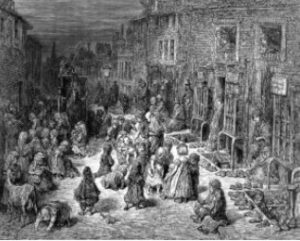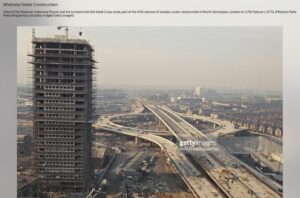The land on which the Silchester Estates were built sits in an area of Notting Dale with a notorious past reputation, earned by the grimy conditions of the piggeries in the early 19th century, the slums of the 1930s and race riots of the 1958.
Until 1844, when the office of Metropolitan Buildings was established, Notting Dale was built up with sheds and shanties and from the 1860s onwards, the area was filled with cheap housing to accommodate the working men and women who were driven from places such as Marble Arch and Pad dington. Most of the residents scraped a living by taking in laundry or keeping pigs.
dington. Most of the residents scraped a living by taking in laundry or keeping pigs.
The squalid conditions in which people lived in the early 19th Century, in the area that became known as the potteries and piggeries, was described in a report that said most houses were “merely hovels in a ruinous condition” and “filthy in the extreme”. The combination of unregulated house building, over population, poor drainage and bad sanitation, all of which were completely ignored and brushed aside by the authorities, finally gave rise to serious concerns.
A Poor Law Commissioners’ report of 1838 reads “houses are built on top of pools of stagnant water, whose floors had sunk and rested at one end of the room in the stagnant pool, while at the other end, being still dry, contains the bed or straw mattress on which the family sleep”.
Not far from the affluent neighboring areas, with their large mansions and villas, Notting Barns was regarded as a shameful blot on the landscape by the borough officials but they chose to refuse responsibility. The social reformer and statistician Charles Booth recorded “terrible hardship just a few hundred yards west of the wealth that radiated outwards from Lansdowne Crescent”. In 1893 the Daily News claimed Notting Dale was the most “hopelessly degraded” place in London.
Seven years later, a medical officer described it as “one of the most deplorable spots, not only in Kensington, but in the whole metropolis”.
Charles Dickens had already drawn attention to the conditions in 1850 when he described the area as “a plague spot scarcely equalled for its insalubrity by any other in London” but nothing was done to ease the problem.
Inevitably, but slowly, evolution took its course. Pigs gradually disappeared and better buildings improved the housing situation. Without any local authority support, churches and public schools provided the best practical and moral assistance and both Harrow and Rugby schools established missions to help the poor.
The estates of North Kensington
Fast forward to the 1950s and onwards, more Council flats were built and replaced many of the slums. Henry Dickens Court was built in 1953 and the high-density Lancaster West estate completed in the late 1970s.
However, over a hundred years from the Charles Dickens’ citation, the situation was still not that much better and most of the area was still in appalling condition. There were still many dilapidated buildings and slums dotted around in the area, especially in the vicinity of Bramley Road, Silchester Road and Latimer Road Station.
The population in the area was increasing at an alarming rate. The census of 1931 had shown that Kensington was one of the only four, among the twenty eight metropolitan boroughs, where an overall increase in population had taken place. But while the other three boroughs still had room for new migrants who came here having been displaced from other parts of London and indeed the rest of the world, there was no more spaces left in Kensington. The major cause of this incoming migration was thought to be the central location of the borough which was attractive for different reasons to both rich and poor.
 Dixon House
Dixon House
As the dire need for more housing was amplified, The Greater London Council started the construction of the Silchester Estate. However, there was also a shortage of Council owned land, which set in motion building of high rise blocks, to maximise their development of the Estate.
Following another widespread slum clearance to make way for the construction of the Westway Flyover, a vast area of land became available. 23 acres of this land which lay directly under the flyover was transferred to the North Kensington Amenity Trust (now Westway Trust) which they developed into the Westway Sports Centre and other community facilities, to recompense the community for the damage and devastation caused by the construction of the road.
The rest of the land, some 1,267 acres, in the north west and north east of Latimer road station was taken over by a compulsory purchase order, issued by the County Council in 1963, to be added to their existing 14 acres which was under construction as part of a large redevelopment scheme for residential purposes. Parts of this land was used to build the second stage of the construction, which completed the Silchester Housing development. And this is where Silchester East and West now remain.
Since its completion, The Silchester Estate has gone through many gradual changes and as it stands now, it has become a desirable and pleasant place to live in and has developed into a blossoming locality.